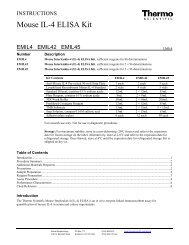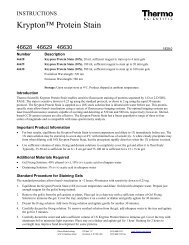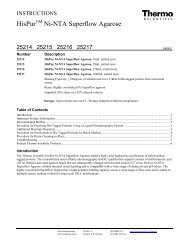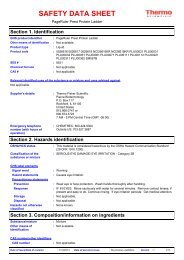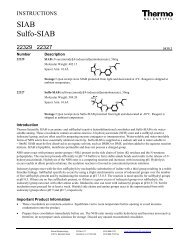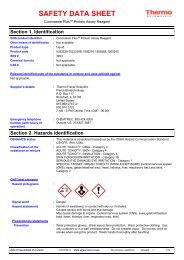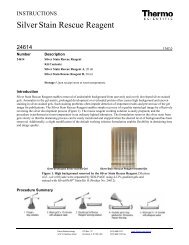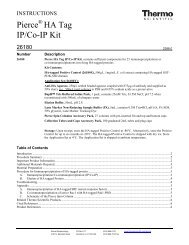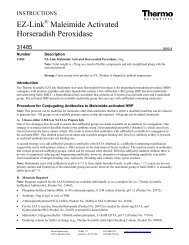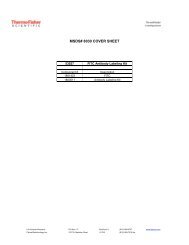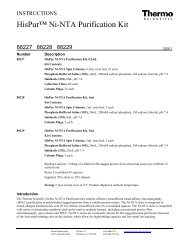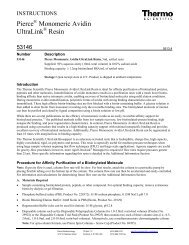Thermo Scientific Pierce Protein Assay Technical Handbook Version 2
Thermo Scientific Pierce Protein Assay Technical Handbook Version 2
Thermo Scientific Pierce Protein Assay Technical Handbook Version 2
You also want an ePaper? Increase the reach of your titles
YUMPU automatically turns print PDFs into web optimized ePapers that Google loves.
Removal of Interfering Substances<br />
Removing Interfering Substances<br />
Virtually every protein detection method known exhibits sensitivity<br />
to the presence of particular reagents in the protein sample.<br />
<strong>Protein</strong>s are typically found in solutions that contain detergents,<br />
buffer salts, denaturants, reducing agents, chaotropic agents<br />
and/or anti-microbial preservatives. These additives may affect<br />
the results of an assay. When a component of a protein solution<br />
artificially increases or decreases the signal of any assay, the<br />
component is considered to be an interfering substance.<br />
Interfering substances can affect the protein assay in the<br />
following ways:<br />
• They can suppress the response of an assay<br />
• They can enhance the response of an assay<br />
• They can result in an elevated background reading<br />
A small amount of interference from many common substances<br />
can be compensated for in the blank designed for a specific<br />
assay. To compensate for the interference, the protein samples<br />
for the standard curve must be diluted in the same buffer as the<br />
protein being assayed.<br />
Often, interfering substances can overwhelm the assay, making<br />
it difficult or impossible to perform. The two most popular assay<br />
methods, Lowry- or Bradford-based assays, are both strongly<br />
affected by various components found in standard sample buffers.<br />
Lowry-based methods are incompatible with reducing and<br />
chelating agents; DTT, β-mercaptoethanol, cysteine, EDTA and<br />
some sugars while Bradford-based methods are incompatible<br />
with most detergents. Unfortunately, many common sample buffers<br />
contain both reducing agents and detergents, Laemmli buffer<br />
for example.<br />
The Compat-Able <strong>Protein</strong> <strong>Assay</strong> Preparation Set (page 26) was<br />
developed to solve this problem. The Compat-Able Reagents<br />
render potentially interfering substances virtually invisible to<br />
either a Lowry- or Bradford-based assay. These unique reagents<br />
dispose of any possible interfering substances in your sample by<br />
selectively precipitating out the protein, allowing the non-protein<br />
sample components to be removed easily. Precipitated protein<br />
is recovered in water or an assay-compatible buffer and then<br />
assayed by any method.<br />
In one round of treatment, Compat-Able Reagents can remove<br />
most any interfering substance, including but not limited to:<br />
• Laemmli buffer<br />
• 3.0M Tris<br />
• 20% glycerol<br />
• 4% SDS<br />
• 3.6M magnesium chloride<br />
• 1.25M sodium chloride<br />
• 350mM dithiothreitol (DTT)<br />
• 5% Triton X-100<br />
• 5% Tween-20<br />
• 125mM sodium citrate<br />
• 200mM glucose<br />
• 200mM sodium acetate<br />
• 5% β-mercaptoethanol<br />
• 200mM EDTA<br />
• 1.0M imidazole<br />
If concentrations of these or other interfering components<br />
exceed this level, more than one round of pre-treatment can<br />
be performed.<br />
In these situations, the interfering substance can be removed<br />
by a variety of means, of which gel filtration and dialysis are the<br />
most common. However both of these methods are time-consuming<br />
and can result in diluted protein samples.<br />
To order, call 800-874-3723 or 815-968-0747. Outside the United States, contact your local branch office or distributor.<br />
25



